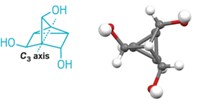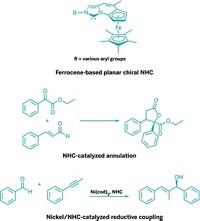Advertisement
Grab your lab coat. Let's get started
Welcome!
Welcome!
Create an account below to get 6 C&EN articles per month, receive newsletters and more - all free.
It seems this is your first time logging in online. Please enter the following information to continue.
As an ACS member you automatically get access to this site. All we need is few more details to create your reading experience.
Not you? Sign in with a different account.
Not you? Sign in with a different account.
ERROR 1
ERROR 1
ERROR 2
ERROR 2
ERROR 2
ERROR 2
ERROR 2
Password and Confirm password must match.
If you have an ACS member number, please enter it here so we can link this account to your membership. (optional)
ERROR 2
ACS values your privacy. By submitting your information, you are gaining access to C&EN and subscribing to our weekly newsletter. We use the information you provide to make your reading experience better, and we will never sell your data to third party members.
Synthesis
Stable, Chiral Polyoxometalates
Potential uses include microporous solids, inorganic drugs, catalysts
by Stu Borman
May 30, 2005
| A version of this story appeared in
Volume 83, Issue 22
CLUSTER CHEMISTRY

The first chiral, nanosized metal-oxide complexes that retain their enantiomeric purity under chemical and thermal conditions that normally cause racemization have been synthesized and characterized. Enantiopure polyoxometalates (POMs) of this kind have long been sought for potential applications such as microporous solids, asymmetric catalysts, and inorganic pharmaceuticals (chiral cluster antiviral agents, for example).
Chemistry professor Craig L. Hill and coworkers Xikui Fang and Travis M. Anderson at Emory University, Atlanta, carried out the study (Angew. Chem. Int. Ed., published online May 20, www3. interscience.wiley.com/cgi-bin/ abstract/110500439).
Chiral POM complexes synthesized in earlier studies either have a chiral POM unit that is not enantiopure or have an achiral POM unit linked to a chiral organic ligand. "It is extremely hard to achieve resolution of the enantiomers of these chiral POMs because of solubility, lability, and/or structural similarity problems," Hill says. "There is only one report of a chiral resolution to date," by a Japanese group in 1970. In contrast, the new POM complexes are enantiopure, owe their chirality primarily to the POM unit (not to the organic ligand), and are stable in both solid-state and solution forms.
Hill and coworkers created the new chiral complexes by reacting mixtures of individual achiral polyoxotungstate units with zirconium ions and either D- or L-tartrate. The chiral tartrate induces the formation of a single enantiomer of the complex, in which two polyoxotungstate units are perched on a zirconium tartrate hub. The chirality resides predominantly in the arrangement of metal and oxygen atoms in the inorganic part of the complex.
"We feel the most important feature of this work is the transfer of chirality intrinsic in a small organic structure, a tartrate, into the much larger, more robust inorganic POM unit," Hill says. "The chirality in the small structure is amplified in the inorganic cluster." Since the paper was written, Hill and coworkers have achieved the same goal by using other natural products besides tartrate.
Chemistry professor Achim Mller of Bielefeld University, in Germany, says: "It's an innovative paper. POMs have properties and applications unmatched by any other group of inorganic compounds, but their chirality has remained largely unexplored." Nothing compares with the new complexes in the earlier literature, he adds. The work "should have a wide range of influence, as stability of the complexes with respect to racemization is new in the POM area."
Chemistry professor Michael T. Pope of Georgetown University, Washington, D.C., calls the technique "an interesting and clever approach. There are no previous examples of isolable enantiomers of large polytungstates," he says. "The significant development here is the ability to generate optically pure enantiomers that do not racemize in solution. My group has been working on development of chiral polyoxometalates via a different a pproach--for many of the same reasons mentioned by Craig."





Join the conversation
Contact the reporter
Submit a Letter to the Editor for publication
Engage with us on Twitter